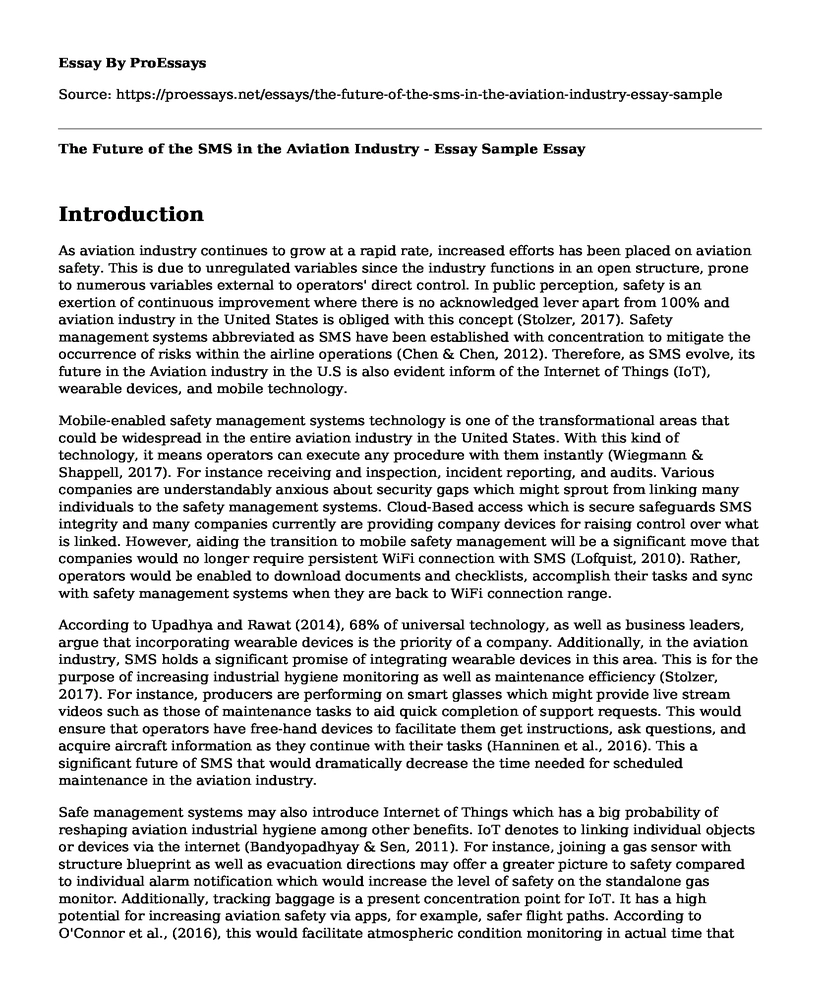Introduction
As aviation industry continues to grow at a rapid rate, increased efforts has been placed on aviation safety. This is due to unregulated variables since the industry functions in an open structure, prone to numerous variables external to operators' direct control. In public perception, safety is an exertion of continuous improvement where there is no acknowledged lever apart from 100% and aviation industry in the United States is obliged with this concept (Stolzer, 2017). Safety management systems abbreviated as SMS have been established with concentration to mitigate the occurrence of risks within the airline operations (Chen & Chen, 2012). Therefore, as SMS evolve, its future in the Aviation industry in the U.S is also evident inform of the Internet of Things (IoT), wearable devices, and mobile technology.
Mobile-enabled safety management systems technology is one of the transformational areas that could be widespread in the entire aviation industry in the United States. With this kind of technology, it means operators can execute any procedure with them instantly (Wiegmann & Shappell, 2017). For instance receiving and inspection, incident reporting, and audits. Various companies are understandably anxious about security gaps which might sprout from linking many individuals to the safety management systems. Cloud-Based access which is secure safeguards SMS integrity and many companies currently are providing company devices for raising control over what is linked. However, aiding the transition to mobile safety management will be a significant move that companies would no longer require persistent WiFi connection with SMS (Lofquist, 2010). Rather, operators would be enabled to download documents and checklists, accomplish their tasks and sync with safety management systems when they are back to WiFi connection range.
According to Upadhya and Rawat (2014), 68% of universal technology, as well as business leaders, argue that incorporating wearable devices is the priority of a company. Additionally, in the aviation industry, SMS holds a significant promise of integrating wearable devices in this area. This is for the purpose of increasing industrial hygiene monitoring as well as maintenance efficiency (Stolzer, 2017). For instance, producers are performing on smart glasses which might provide live stream videos such as those of maintenance tasks to aid quick completion of support requests. This would ensure that operators have free-hand devices to facilitate them get instructions, ask questions, and acquire aircraft information as they continue with their tasks (Hanninen et al., 2016). This a significant future of SMS that would dramatically decrease the time needed for scheduled maintenance in the aviation industry.
Safe management systems may also introduce Internet of Things which has a big probability of reshaping aviation industrial hygiene among other benefits. IoT denotes to linking individual objects or devices via the internet (Bandyopadhyay & Sen, 2011). For instance, joining a gas sensor with structure blueprint as well as evacuation directions may offer a greater picture to safety compared to individual alarm notification which would increase the level of safety on the standalone gas monitor. Additionally, tracking baggage is a present concentration point for IoT. It has a high potential for increasing aviation safety via apps, for example, safer flight paths. According to O'Connor et al., (2016), this would facilitate atmospheric condition monitoring in actual time that might aid redirect flight routes more rapidly and effectively hence increasing safety in the aviation industry.
Conclusion
It is evident that as SMS continues to evolve, there is a clear future of what it might introduce in the aviation industry. This might be seen through presence and incorporation of the Internet of Things (IoT), wearable devices, and mobile technology in its process. Therefore, to ensure that SMS is efficiently and rapidly providing safety, operators in the aviation industry should focus on the possible future of safety management systems to ensure that a 100% safety level is achieved.
References
Bandyopadhyay, D., & Sen, J. (2011). Internet of things: Applications and challenges in technology and standardization. Wireless Personal Communications, 58(1), 49-69.
Chen, C. F., & Chen, S. C. (2012). Scale development of safety management system evaluation for the airline industry. Accident Analysis & Prevention, 47, 177-181.
Hanninen, K., Hansson, H., Thane, H., & Saadatmand, M. (2016). Inadequate risk analysis might jeopardize the functional safety of modern systems.
Lofquist, E. A. (2010). The art of measuring nothing: The paradox of measuring safety in a changing civil aviation industry using traditional safety metrics. Safety Science, 48(10), 1520-1529.
O'Connor, P., O'Dea, A., Kennedy, Q., & Buttrey, S. E. (2011). Measuring safety climate in aviation: A review and recommendations for the future. Safety Science, 49(2), 128-138.
Stolzer, A. J. (2017). Safety management systems in aviation. Routledge.
Upadhya, V., & Rawat, D. S. (2014). INTELLIGENT AIRPORTS-YOUR RUNWAY TO SUCCESS. DOI= www. wipro. com/.../intelligent-airports-your-runway-tosuccess. pdf.
Wiegmann, D. A., & Shappell, S. A. (2017). A human error approach to aviation accident analysis: The human factors analysis and classification system. Routledge.
Cite this page
The Future of the SMS in the Aviation Industry - Essay Sample. (2022, Jul 25). Retrieved from https://proessays.net/essays/the-future-of-the-sms-in-the-aviation-industry-essay-sample
If you are the original author of this essay and no longer wish to have it published on the ProEssays website, please click below to request its removal:
- Research Paper on American Airlines
- Essay Sample on Health Impacts of Hydraulic Fracking
- Forensic Cell Site Analysis: Unveiling the Technology Behind It - Essay Sample
- Green Innovations: Re-Usage, Recycling & Pollution Prevention - Essay Sample
- Autonomous Vehicle Industry: Decades of Research Leads to Safer, More Efficient Transport
- Maximizing Potential: The iPhone SE in the Modern Era - Essay Sample
- Unlock AI Benefits: Establish Separate Units for Optimal Impact - Essay Sample







